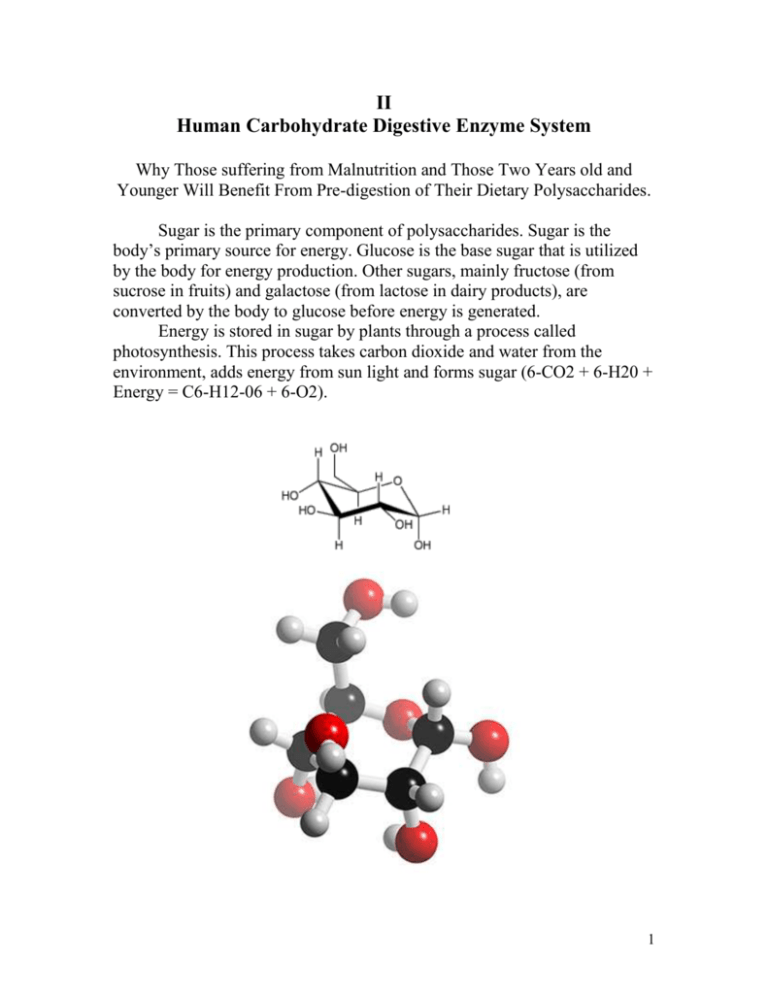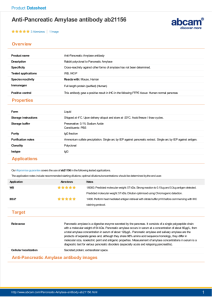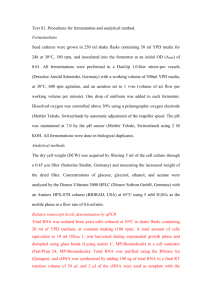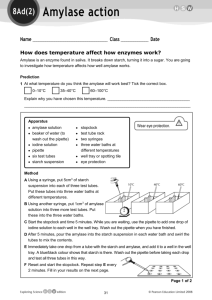dietary carbohydrate
advertisement

II Human Carbohydrate Digestive Enzyme System Why Those suffering from Malnutrition and Those Two Years old and Younger Will Benefit From Pre-digestion of Their Dietary Polysaccharides. Sugar is the primary component of polysaccharides. Sugar is the body’s primary source for energy. Glucose is the base sugar that is utilized by the body for energy production. Other sugars, mainly fructose (from sucrose in fruits) and galactose (from lactose in dairy products), are converted by the body to glucose before energy is generated. Energy is stored in sugar by plants through a process called photosynthesis. This process takes carbon dioxide and water from the environment, adds energy from sun light and forms sugar (6-CO2 + 6-H20 + Energy = C6-H12-06 + 6-O2). 1 pictures of glucose[9] Animals obtain carbohydrates by eating foods that contain them. The animal digests them (breaks them down into base sugars), and absorbs them. Body cells and tissues then either convert the sugar molecules into the storage polysaccharide called glycogen or metabolize the sugar molecules into H20, CO2, and energy, the opposite process of photosynthesis. All polysaccharides are made up of chains of sugar molecules linked together. There are two main types of storage polysaccharides, carbohydrates in plants and glycogen in animals. These are chains of glucose. Carbohydrate consists of amylose, straight chains. and amylopectin, made up of chains with branches. Glycogen, which is primarily stored in muscle and liver, is more highly branched than amylopectin. These are held together by alpha bonds, 1-4 bonds in straight chains and 1-6 bonds at branches. These bonds can be broken down by human enzymes called amylase (Lactase is an enzyme that breaks down lactose which contains a beta bond) and debranching enzyme. Cellulose is a noncarbohydrate polysaccharide which has glucose linked in straight chains by beta bonds which can not be digested by humans. Ruminants such as cows and insects such as termites digest cellulose by harboring bacteria in their digestive systems that produce enzymes that are capable of digesting cellulose. Cellulose acts as a fiber for human consumption. The major enzymes involved in carbohydrate, glycogen and disaccharide digestion are alpha amylase, beta amylase, debranching enzyme, maltase, and lactase. Beta amylase is found in seeds. Alpha amylase is produced by the seeds of germinating plants. In animals, digestive alpha amylase and debranching enzyme are produced by salivary glands and the pancreas. Alpha amylase attacks the end of the carbohydrate chains, breaking the carbohydrate down at the 1-4 bonds to the disaccharide maltose. Amylose can be broken down in this fashion. Alpha amylase will create maltose up to a branch. It can not cleave the branch 1-6 bonds, leaving residual polysaccharides and oligosaccharides or limit dextrins (compounds made of up to ten monosaccharides). Alpha amylase can skip past the 1-6 bonds and continue cleaving the 1-4 bonds which the plant beta amylase can not do. Debranching enzyme cleaves the 1-6 bonds, allowing beta amylase to proceed with its digestive activities. 2 Maltase (and lactase) is an enzyme manufactured in the brush border cells of the duodenum and jejunum. This enzyme completes the digestive process by breaking down maltose not digested by alpha amylase into two glucose molecules and sucrose into a glucose and a fructose molecule (lactose, which is not broken down by maltase, is similarly broken down into glucose and galactose by lactase). These sugar molecules are absorbed into the blood stream. Salivary amylase and debranching enzyme begin the digestion of ingested carbohydrate. This process is limited. First, there is no maltase. Second, once the meal is swallowed and it reaches the stomach, the enzymes, which are proteins, are denatured by the acid content of the stomach and are partially digested by pepsin. This occurs even in neonates and infants. Completion of carbohydrate and glycogen digestion occurs in the small intestine by alpha amylase and debranching amylase produced by the pancreas and maltase produced by the brush border cells of the duodenum and jejunum. There is a significant deficiency of amylase production in neonates, infants, and toddlers. Amylase, in small amounts, can be found in the saliva of neonates.[1] Neonatal serum amylase levels are very low.[3] The duodenal fluid of newborns contains no amylase.[2] Serum pancreatic amylase levels are very low in infants younger than 6 months old. These levels then increase with age. Serum salivary amylase levels reach normal adult levels by age 5 years old. Pancreatic amylase appears in the serum at a later age. Below 3 months there are no pancreatic amylases in the serum. These levels slowly increase over time reaching normal adult levels between 3 the ages of 10 and 15 years old.[4] There is some amylase in duodenal fluid at approximately 2 years old.[2] Maltase activity reaches the lower range of normal adult activity by 28 to 32 weeks of gestation. Therefore, both healthy premature and full-term infants should have adequate maltase activity.[10] Amylase production has been shown to be reduced during marginal and severe malnutrition in children.[7] Decreased pancreatic enzyme production has frequently been recorded in protein energy malnutrition because the pancreas requires optimal nutrition for enzyme synthesis. The pancreatic head size, by ultrasound, is significantly smaller in malnutrition at the same time that amylase levels are also lower. With nutritional rehabilitation, the pancreatic head size and amylase levels concomitantly return to normal.[8] Maltase activity is present but reduced secondary to villous atrophy.[12] The above discussion documents that the pre-digestion of starch-based food by use of alpha amylase found in barley malt will aid in improvement of the nutritional status of those less than two years old and those suffering from malnutrition by producing maltose. The presence of maltase in neonates and infants results in glucose production and absorption by the gastrointestinal tract. This activity is reduced but present during episodes of malnutrition. In addition, maltase is present in barley malt, which compensates for the small bowel changes that result in decreased maltase production by the reduced number of brush border cells. The limited dextrins are not predigested because debranching enzyme is not present in barley malt. Debranching enzyme is rapidly denatured at 65 degrees centigrade, and kilning reaches 70 degrees centigrade. Thus, while glucose is ultimately made available, complete pre-digestion of carbohydrate to maltose does not occur utilizing barley malt flour.[11] 4 BIBLIOGRAPHY 1 – The Contribution of Salivary Amylase to Glucose Polymer Hydrolysis in Premature Infants – Murray R.D., Kezner B., Sloan H.R., McClung H.J., Gilbert M., Ailabouni A – Pediatric Resident, Feb 1986 Vol. 20 No 2, pp. 186-91 2 – Development of Functional Response in Humane Exocrine Pancreas – Emanual Lebenthal MD, and P. C. Lee PhD – Pediatrics October 1980 Vol. 66 No. 4 , pp. 556 – 560 3 – Serum Levels of Immunoreactive Trypsin During Development: Comparison with Levels of Lipase and Amylase – Colombo C., Maiavacca R., Ronchi M., Bottani P., Stripparo L., Corbetta C., and Sereni L.P. – Pediatric Gastroenterological Nutrition August 1989 Vol. 9 No 2, pp. 194-9 4 – Sources of Serum isoamylases and Their Normal Range of Variation with age – Skude G. – Scandinavian Journal of Gastroenterology 1975 Vol. 10 No 6, pp. 577-84 5 – Maltase – Accessed at http://medicaldictionary.thefreedictionary.com/maltase on 11/9/08 6 – Why delay Solids? – Accessed at http://www.kellymom.com/nutrition/solids/delay-solids.html on 11/10/08 7 – Pancreatic and Salivary Amylase Activity in undernourished Columbian Children – Watson R.R., Tye J.G., McMurray, and Reyes M.A. – American Journal of Nutrition April 1977 Vol. 30 No. 4, pp. 599-604 8 – Pancreatic size I Protein Energy Malnutrition: a predictor of Nutritional Recovery – El-Hodhod M.A., Nassar M.F., Hetta O.A., and Gomaa S.M. – European Journal of Nutrition April 2005 Vol. 59 No. 4, pp. 467-73 9 – Glucose, What is Glucose About its science, Chemistry and Structure – Accessed at www.3dchem.com/molecules.asp?ID=423 on 11/10/08 10 – Allergy Advisor, A case Study – Accessed at http://allergyadvisor.com/Educational/June07.htm on 11/10/08 11 – The Theory of Mashing – Accessed at www.homebrewtalk.com/wiki/index.php/Enzymes on 11/10/08 12 – Contribution of Villous Atrophy to Reduced Intestinal Maltase in Infants With Malnutrition – Nichols B.L., Nichols V.N., Putman M., Avery 5 S.E., Fraley J.K., Quaroni A., Shiner M., Sterchi E.E., and Carrazza F.R. – Journal of Pediatric Gastroenterology and Nutrition 2000 Vol. 30 No. 5, pp 494-502 6






